Inventing the Magic 8-Ball
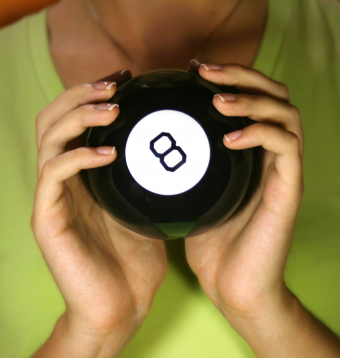 Can a plastic orb connect you to the spirit world and lift the future’s filmy veil? OUTLOOK NOT SO GOOD. Can it at least give good advice? REPLY HAZY, TRY AGAIN. Can a toy company make money selling it? SIGNS POINT TO YES!
Can a plastic orb connect you to the spirit world and lift the future’s filmy veil? OUTLOOK NOT SO GOOD. Can it at least give good advice? REPLY HAZY, TRY AGAIN. Can a toy company make money selling it? SIGNS POINT TO YES!
A SEEKER BORN EVERY MINUTE
Wartime has long been a boom time for spiritualists, mostly because people long for any news about loved ones at the battlefront. In the 1940s, a woman named “Madame” Mary Carter was capitalizing on that opportunity, plying her trade as a professional clairvoyant in Cincinnati. Her best séance stunt was one she called the Psycho-Slate, consisting of a chalkboard inside a box, with a lid covering it. When a client asked a question, Carter would close the lid, and after a short interval of muffled chalkboard scratching, she would dramatically flip open the lid to reveal the spirit world’s answer, written with chalk in a ghostly scrawl. (How she did it remains a mystery.)
TELL A FORTUNE, MAKE A FORTUNE?
Mary Carter had a son named Albert who had little use for any spirits that couldn’t be drunk straight from a bottle. When sober, however, he fancied himself an inventor, and seeing the success of his mother’s Psycho-Slate, Albert Carter came up with his best idea ever: a portable fortune-telling device that any spiritual seeker could use at any time or place.
It took some time for Carter to work out the details. It had to look mysterious, it had to offer a variety of answers and, because he had no capital to work with, it had to be cheap to build. He went to work using what he knew best—murky liquids in cans and bottles—and developed what he called the Syco-Seer Miracle Home Fortune Teller—a seven-inch can-shaped device with a glass window on each end. The inside of the can was divided in two; each half contained a six-sided die floating in a dark, viscous liquid (according to some accounts, molasses from his mother’s kitchen) and each of the die’s six sides was inscribed with a short answer.
His reasoning for having two compartments isn’t clear, but perhaps it was for efficiency: You could get an answer from one end, then turn it over and get the next answer with little lag time. In 1944 Carter filed for a patent, made a prototype, and began showing it around Cincinnati’s toy and novelty shops.
YOU WILL MEET A HELPFUL STRANGER
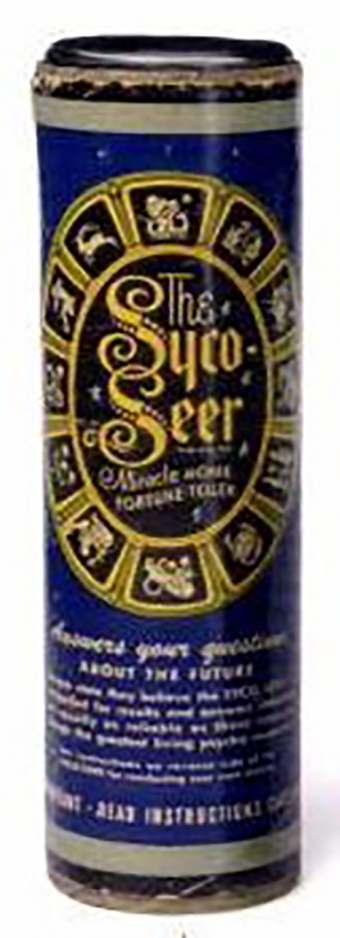 One of the storekeepers, Max Levinson, not only wanted to stock Syco-Seers, he was very interested in helping Carter produce and market them. Levinson brought in his brother-in-law, Abe Bookman, an engineer from the Ohio Mechanical Institute, who suggested improvements to Carter’s design—adding ridges inside the chamber to make the die spin and better randomize the answers. He also hired a designer to give the Syco-Seer’s outer label a mystical appeal.
One of the storekeepers, Max Levinson, not only wanted to stock Syco-Seers, he was very interested in helping Carter produce and market them. Levinson brought in his brother-in-law, Abe Bookman, an engineer from the Ohio Mechanical Institute, who suggested improvements to Carter’s design—adding ridges inside the chamber to make the die spin and better randomize the answers. He also hired a designer to give the Syco-Seer’s outer label a mystical appeal.
In 1946 the three men formed a partnership, which—in a nod to his two creative partners’ first names—Levinson called the Alabe Crafts Corporation. Bookman arranged for a manufacturer and planned for the retail release of the Syco-Seer in 1947. At just about the same time, Albert Carter’s alcoholism and self-neglect had finally caught up with him and he died. “When he was sober, he was a genius,” Bookman recalled to a Cincinnati Post reporter a few years later. “He stayed in flophouses and he was always broke. But I bought every idea he ever had, and that gave him enough to keep going.”
I SEE A PATENT IN YOUR FUTURE
Carter’s patent came through the following year, and luckily for Bookman and Levinson, he had signed rights over to the partnership before he died. Given new creative freedom to experiment with the design, Bookman began making changes that Carter had resisted.
First, while the Syco-Seer was attracting curious browsers in stores, it wasn’t generating sales, and Bookman was convinced that it was priced too high. To bring down the price, Bookman reduced costs by cutting Carter’s double-chambered design in half, using only one chamber, one die, and one window. He also decided that Carter’s mother was a good judge of product names. He borrowed her chalkboard gimmick’s name, calling his 3½-inch single-chambered device “Syco-Slate, the Pocket Fortune Teller.” Next, he decorated it with the 12 zodiac signs and an illustration of a gypsy fortune-teller.
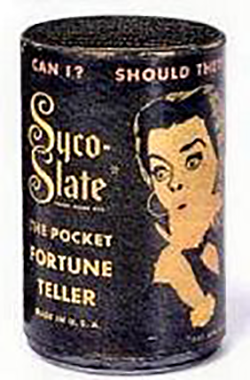 In stores, models dressed as gypsies demonstrated how to use the device. But demonstrations weren’t really needed. On the top of the cylinder were the instructions:
In stores, models dressed as gypsies demonstrated how to use the device. But demonstrations weren’t really needed. On the top of the cylinder were the instructions:
Place left hand on this end. Ask a “yes or no” question about the future, wait 10 seconds and turn SYCO-SLATE over. Answer will appear on “Spirit Slate” in the window.
ON THE BALL
Although the price of the new incarnation was lower, the Syco-Slate didn’t sell much better than the Syco-Seer had. Why? It looked like a can of peas. Bookman racked his brain—what did people expect when they had their fortunes read? Then it came to him: a crystal ball. Late in 1948, Bookman began encasing Syco-Slates in a translucent, iridescent ball. Then he changed the six-sided die to a 20-sided one, and even hired a University of Cincinnati psychology professor named Lucien Cohen to come up with answers for each of its 20 faces. Bookman was sure he had a winner this time.
He didn’t. The crystal ball flopped too.
CONCENTRATE AND ASK AGAIN
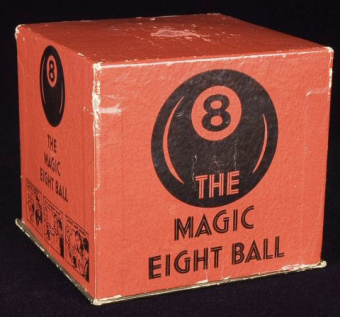 Bookman was out of ideas. He’d put a lot of money, time, and sweat into this thing. He was sure it was going to strike it big, yet nothing seemed to work. Then something strange happened, almost as if it had been preordained by the stars: Bookman got a message from beyond—just beyond Ohio’s western border. A representative of the Brunswick Billiards Company of Chicago called to say that Brunswick needed a unique promotional item—would it be possible to change the skin of Alabe’s crystal ball and make it look like a billiard ball?
Bookman was out of ideas. He’d put a lot of money, time, and sweat into this thing. He was sure it was going to strike it big, yet nothing seemed to work. Then something strange happened, almost as if it had been preordained by the stars: Bookman got a message from beyond—just beyond Ohio’s western border. A representative of the Brunswick Billiards Company of Chicago called to say that Brunswick needed a unique promotional item—would it be possible to change the skin of Alabe’s crystal ball and make it look like a billiard ball?
It was a strange request, and it didn’t make sense. Who ever heard of an 8-ball that tells fortunes? But Bookman, looking for a way to make some money and reduce his surplus stock, agreed to do it.
OUTLOOK GOOD
Even Madame Mary Carter couldn’t have foreseen that a fortune-telling billiard ball would strike a chord with the public. Maybe it was because the absurd 8-ball design stripped away that phony gypsy fortune-teller aura, making the object clearly designed as a fun toy instead of an occult item. By 1950 most Americans were planted firmly in the material world. They might enjoy reading fortune cookies and newspaper horoscopes, but they weren’t trying to get genuine answers or relief from war anxieties. Most saw fortune-telling as something offbeat to laugh about with friends.
It turned out that a “Magic 8-Ball” fit right in. The Brunswick Billiards Company quickly distributed their supply, but people were contacting Alabe Crafts asking for more. Abe Bookman was smart enough to recognize that he had a good thing going. Albert Carter’s invention finally found its market.
RANDOM FACTS AND QUICK ANSWERS
- Half of the 20 answers on a Magic 8-Ball are positive. Five are noncommittal, and the remaining five are negative.
- What’s inside a Magic 8-Ball? First of all, there’s a cylinder that’s very much like Carter and Bookman’s original Syco-Seer / Syco-Slate design. It’s filled with a blue dye dissolved in alcohol. The 20-sided die has raised white letters and openings for the liquid to enter. This makes the die just barely buoyant, which accounts for the way it slowly floats to the top, making the answer gradually emerge from the gloomy dark liquid.
- There is one recent addition to the original Magic 8-Ball design. When Ideal Toys bought Alabe Crafts in 1971, their designers tackled a problem that had vexed users for decades: annoying bubbles appeared in the message window, making it hard to see the answers. In 1975 Ideal patented the solution—the “Bubble-Free Die Agitator,” consisting of an inverted funnel that routes air into an internal bubble trap. The BFDA has been part of the Magic 8-Ball ever since.
- Some users seem to think they’re supposed to shake the 8-Ball when they ask their questions. That’s wrong. Agitating an 8-Ball is likely to release bubbles from the bubble catcher, obscuring the words in the inky blue window into the future.
- If you wanted to get every one of the 20 possible answers, it would take an average of 72 questions.
- The 20-sided shape of the Magic 8-Ball die is an icosahedron. In the natural world, it’s a shape that shows up in viruses, amoebas, crystals, and a form of carbon called fullerene. In the unnatural world, it’s a shape found in dice made for role-playing games and in Buckminster Fuller’s “Fuller Projection Map,” a nearly round globe that can be opened up and laid flat on a table with very little distortion of the land area’s sizes and shapes.
- About a million Magic 8-Balls are sold annually.
- A coincidence? A look into the future? In a wartime short film called You Nazty Spy (1940), the Three Stooges parody Hitler and his henchmen’s proclivity for seeking occult guidance. In the film, a psychic named Mati Herring tells their future with what she calls “the Magic Ball”—an oversized 8-ball that looks exactly like the well-known toy-to-be.
- Is the 8-Ball cursed? See if you can follow the bouncing Magic 8-Ball through its various owners: In 1971 Ideal Toys bought the Magic 8-Ball from Alabe Crafts. In 1982 Ideal was acquired by CBS for its new CBS Toys Company. Three years later, in 1985, the broadcaster got out of the toy business and sold its Ideal division (including the 8-Ball) to Viewmaster. Four years after that, Viewmaster was acquired by Tyco Toys, itself having been acquired by Consolidated Foods 20 years earlier. In 1997 Consolidated—now called the Sarah Lee Corporation—sold the remains of Tyco, including the 8-Ball, to Mattel Toys. Since 1997 Mattel has owned the Magic 8-Ball. However, if the curse is real, it’s probably just a matter of time before Mattel reads the writing on the ball: “OUTLOOK NOT SO GOOD.”
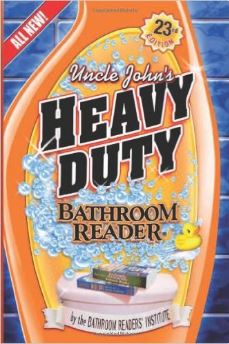 This article is reprinted with permission from Uncle John’s Heavy Duty Bathroom Reader. The big brains at the Bathroom Readers’ Institute have come up with 544 all-new pages full of incredible facts, hilarious articles, and a whole bunch of other ways to, er, pass the time. With topics ranging from history and science to pop culture, wordplay, and modern mythology, Heavy Duty is sure to amaze and entertain the loyal legions of throne sitters.
This article is reprinted with permission from Uncle John’s Heavy Duty Bathroom Reader. The big brains at the Bathroom Readers’ Institute have come up with 544 all-new pages full of incredible facts, hilarious articles, and a whole bunch of other ways to, er, pass the time. With topics ranging from history and science to pop culture, wordplay, and modern mythology, Heavy Duty is sure to amaze and entertain the loyal legions of throne sitters.
Since 1987, the Bathroom Readers’ Institute has led the movement to stand up for those who sit down and read in the bathroom (and everywhere else for that matter). With more than 15 million books in print, the Uncle John’s Bathroom Reader series is the longest-running, most popular series of its kind in the world.
If you like Today I Found Out, I guarantee you’ll love the Bathroom Reader Institute’s books, so check them out!
| Share the Knowledge! |
|




